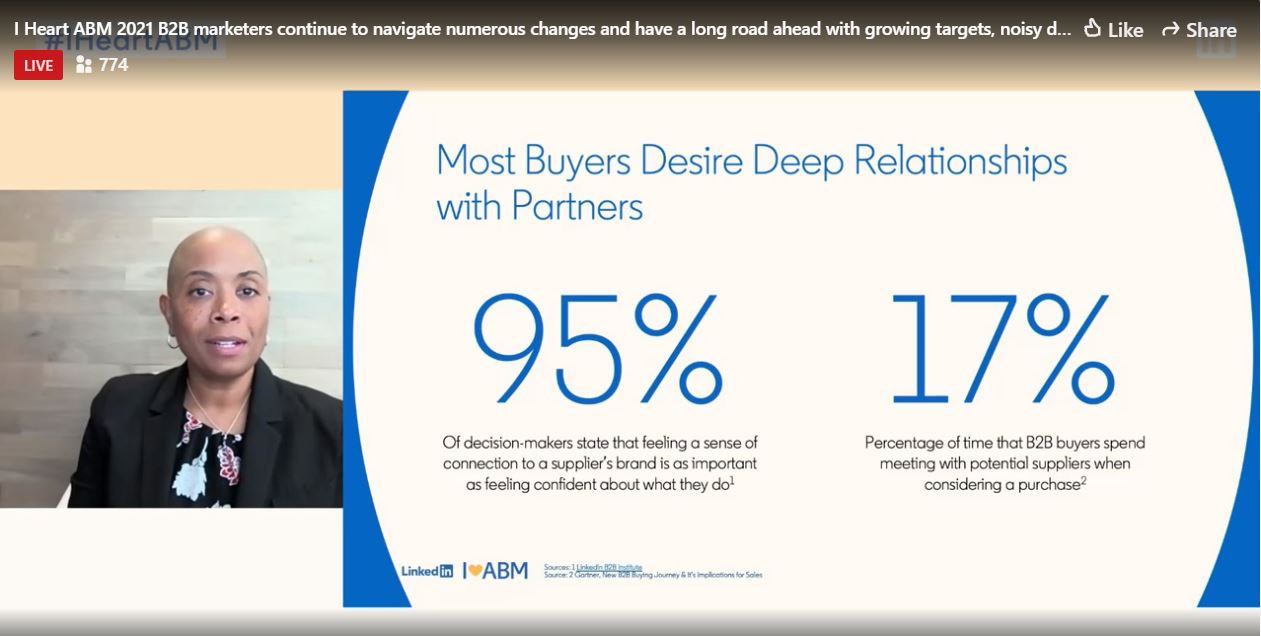ABM is getting more human in a digital-first world. Organizations are beginning to focus more on 1:1 experiential ABM programs, blending account-based plays and traditional demand gen to build more targeted strategies that humanize their brand and deliver unique experiences that cater to key decision makers’ needs. This shift emphasizes the importance of collaborating with teams across the organization to support accounts throughout their journeys.
“ABM done well is a team sport within companies,” explained Liz Demers, Manager of Ad Partnerships at LinkedIn, in an opening statement during LinkedIn’s recent I Heart ABM event. “It’s about building bridges between marketing and sales, developing that shared language and understanding how to align around unified goals and purpose. And when you’re talking about customers, it’s about taking that empathetic approach, developing a unique understanding of how to support, speak to and nurture a diverse community of decision makers. It shows that we don’t need to sacrifice what is human.”
As teams double down on ABM, key priorities for practitioners include:
- Building an account-based strategy that prioritizes personalized 1:1 engagement;
- Aligning across the organization to foster targeted plays to humanize their marketing efforts; and
- Making meaningful connections to drive greater engagement and revenue.
Combining Demand Marketing & ABM For Meaningful Account Experiences
Research from Demand Gen Report found that 61% of organizations are adopting account-based approaches to enhance demand gen initiatives and build 1:1 account experiences. Adam Needles, CEO of ANNUITAS and LinkedIn partner, defined this collaborative approach as “ABDM” at the I Heart ABM event.
“What’s old is new again,” said Needles. “Success requires us taking the best of not only what we have from the ABM world, but also what we have from more traditional demand marketing. Demand marketing has really grown up in the last couple of years, which brings a lot of new capabilities to the table around customer experience.”
By blending demand marketing metrics and existing account data, marketers can create highly targeted content and personalized conversations that engage key accounts. They can also map out account journeys to craft experiences based on which stage they are in for more granular targeting.
Overhauling ABM For Account Retention & Workflow Efficiency

Allyson Hughley, Global Director of Customer Insights at LinkedIn, highlighted that 95% of decision makers want to feel a connection with the companies they are buying from, but can only devote 17% of the buyer journey to connecting with anticipated suppliers. This results in a potentially less engaged account and a lower likelihood that the buyer trusts and will buy from that vendor.
To counteract this, Hughley stressed that marketers and organizations need to build agile ABM experiences that establish meaningful connections, deliver all relevant information to address buyer challenges and provide context as to who the organization is. This strategy has marketers navigating accounts and guiding decision makers through their journeys and into the future.
“It is no longer just about tackling and helping accounts navigate the present, but providing that forward view that helps them understand how to see around corners and plan effectively for the future,” said Hughley. “These two competing dynamics of being both deeply known and understood, but sufficiently agile and new in thinking and presentation, help marketers appeal to and address the challenges that customers are facing in unprecedented times. This influences decisions and increases respect to suppliers.”
The research also revealed the importance of ABM as a workflow model that keeps the organization aligned for account engagement. Although the marketing team’s role in ABM has increased by 72% in 2021, there are too many outside influences that can detract from the quality of marketing programs. Hughley maintained that a defined ABM process can help teams not only accurately connect with their buyers’ needs, but also remain aligned on their ABM goals.
“ABM could not be more important as an approach to connecting effectively with the needs of marketers,” Hughley continued. “The idea of presenting in a unified way to accounts, being able to strip out the complexity and speak in a unified voice — and doing so across buying groups and a diverse range of stakeholders — is increasingly important. At the end of the day, it is the idea of how you strip out complexity and create clarity in the process.”
Consolidating Data & Processes For Multichannel ABM
Experts emphasize the need to consolidate ABM processes and technologies into one actionable strategy. As marketers shift to a multichannel engagement strategy, it’s important to combine tech and data to create targeted, personalized experiences so all relevant stakeholders are involved, according to Amanda Malko, CMO for G2.
“When you think about the history of ABM, it started as a singular channel or email and then branched out to the multichannel,” said Malko. “I think that’s where we are in the maturity and life cycle of ABM. As the buying committee gets more complex and diverse, and as ABM platforms become more omnichannel, you’re going to have different stakeholders who are going to be involved in marketing decisions. And that’s where ABM can be really helpful.”
Latane Conant, CMO of 6sense, spoke to the data angle of ABM, highlighting how the consolidation of account data has led to more guesswork than actionable insights. To avoid this, she suggested marketers take the account data within their databases and create or adopt forecasting models that provide meaningful insights into what target accounts need and when they need it.
“I think it’s time to burn the huge spreadsheets with conversion rates,” explained Conant. “All the custom CRM reports have all the fancy AI and forecasting. I want that type of analysis for my pipeline. Forecasting where we are in terms of the amount of pipeline we’ve created and how much we need to create — and looking at all those critical conversions — is pivotal for modern ABM.”
Jon Miller, CMO and Chief Product Officer at Demandbase, took a different approach to account data, noting that traditional marketing metrics do not provide enough indication of buying intent and the health of account deals. He suggested that marketers focus on engagement metrics to measure their ROI, as they provide accurate leading indicators into ABM program health that can help marketers pivot their strategies on the fly.
“I’ve been telling marketers for years: You’ve got to focus on the revenue metrics — the things that the CEO and the CFO care about,” said Miller. “One of the things I’ve learned about ABM is that ABM sales cycles take a long time, so we need leading indicators that tell us if we’re on the right track. Engagement metrics are my favorite, as insight into engagement really helps you focus your time and energy on what is engaging key accounts and double down.”
One-to-one account experiences are becoming the backbone of modern ABM programs, with marketers combining their traditional demand gen and account-based plays to engage accounts on a more human level. Marketers are also measuring new data metrics and implementing new processes to build more human connections with their accounts on multiple channels.
“From the insights to the panel discussions, it is clear that ABM is about more than the technology, data and revenue,” said LinkedIn’s Demers. “It’s about building human relationships and establishing buyer trust. It is a really, deeply human strategy.”







